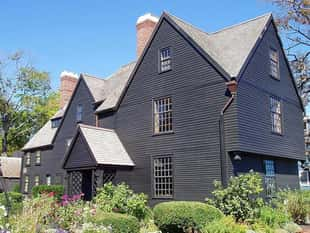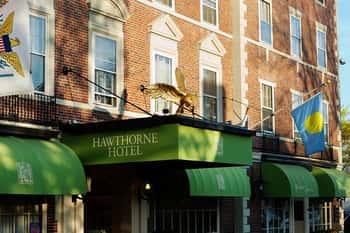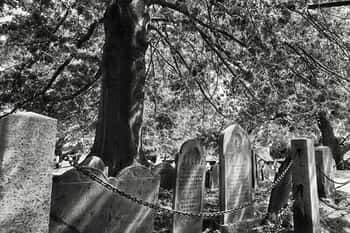On the lookout for ghosts? Take a peak off Proctor’s Ledge.
Once the “hanging hill” of Salem’s Witch Trials, Proctor’s Ledge has seen its unfair share of suffering. Nineteen of the falsely accused were hanged at the location, with their bodies discarded in a nearby crevice. Yet Proctor’s Ledge wasn’t identified as the execution site until January 2016. Until then, it was erroneously thought to be Gallows Hill. The mix-up is understandable: located between Proctor Street and Pope Street, Proctor’s Ledge is quiet and unassuming. It overlooks a Walgreens; it’s residential. Unlike Gallows Hill, it’s not a “mise-en-scène” for a hangman’s rope. Or is it?
In 1692, this small village of Essex County, Massachusetts, bore witness to America’s most lethal witch hunt. Over 200 were accused, and nineteen executed. Sarah Good, Elizabeth Howe, Susannah Martin, Rebecca Nurse, and Sarah Wildes were the first “witches” hanged at Proctor’s Ledge, but they would not be the last. Their charge? Witchcraft based on spectral evidence – the “eyewitness” accounts of the afflicted.
If two young girls were seized with “strange fits,” what better suspect than the Supernatural?
Witchcraft was the easy excuse. The “Witch Hysteria” had Salem Village under its spell. Paranoia propagated prejudice; neighbor turned upon neighbor. The testimonies were unsubstantiated, the testifiers untrue. Although the accused protested their innocence, they were hanged without fair trial. Their bodies were unceremoniously castoff in “the crevice.”
Ghastly history creates ghoulish company. Do Salem’s spirits consort at Proctor’s Ledge?
Why Not Gallows Hill?
There are over 1,000 documents from Salem’s Witch Trials, yet none of the accounts specify where the hangings took place. Gallows Hill was once thought to be the execution site, but the slope of Gallows Hill made it unlikely. For the carts carrying the accused, Gallows Hill would be too difficult to climb. Salem’s executions were also public events, and Gallows Hill is blocked from view by Ledge Hill. Proctor’s Ledge is, by comparison, lower and more visible. Proctor’s Ledge therefore made the witchcraft executions an unrestricted spectacle – shocking or sickening those not yet subject to Salem’s superstition.
Benjamin Nurse, son of the accused Rebecca Nurse, likewise wrote that he had taken a creek from the Nurse Homestead to the North River in an effort to retrieve his mother’s body. The North River allegedly brought Benjamin to the base of “Hanging Hill.” Gallows Hill is far from the waterway, though Proctor’s Ledge overlooks North River. North River was even once connected to Bickford’s pond, the former base of Proctor’s Ledge. Benjamin Nurse would have been able to access Proctor’s Ledge by waterway. Gallows Hill is comparatively – and imperatively – landlocked.
The Gallows Hill Project confirmed Proctor’s Ledge as the execution site in January 2016. Using eyewitness accounts, trial papers, and geo-archaeological remote sensing, the Gallows Hill Project pinpointed precisely where Salem’s hanged were hung. Yet Sidney Perley was the first to suggest Proctor’s Ledge, writing in 1921 that the hangings took place at this “rocky outcrop.” Salem purchased Proctor’s Ledge in 1936, fifteen years after Perley voiced this suspicion. Although they named the property “Witch Memorial Land,” Gallows Hill was still considered the execution site. Proctor’s Ledge was transformed into a public park, going otherwise overlooked.
Perley’s hypothesis was discounted until a team of scholars reconsidered his theory in 2010. Led by Salem State University’s Emerson Baker, the Gallows Hill Project teamed up with Virginia’s Scholars Lab to establish Salem’s 1692 location of execution. The Gallows Hill Project additionally included Elizabeth Peterson, director of Salem’s Corwin House, and filmmaker Tom Philips. After six years of study, they decided that Sidney Perley had been right: Proctor’s Ledge had been Salem’s “Hanging Hill.” Nineteen had been unjustly executed on the outskirts of Salem.
Does Proctor’s Ledge house human remains? Some would suggest so.
In 1700, Robert Calef wrote that Burroughs, a victim of Salem’s “witch hysteria,” was “dragged by a Halter to a Hole, or Grave, between the Rocks, about two feet deep; his Shirt and Breeches being pulled off, and an old pair of Trousers of one Executed put on his lower parts: he was so put in, together with Willad and Carrier, that one of his Hands, and his Chin, and Foot of one them, was left uncovered.” Perley believed that this “hole” was the “crevice” of Proctor’s Ledge, though the Gallows Hill Project is hesitant to agree.
The Gallows Hill Project instead think that Proctor’s Ledge was a temporary and unintentional burying ground, with the bodies of the deceased later claimed by their loved ones. Nevertheless, the Gallows Hill Project does confirm that.
The implication is that it was too hot for the usual morning period before burial, and the bodies needed to get below ground as soon as possible. So, it is quite possible that the five executed on August 19 would have been buried in a shallow grave or thrown in a crevice and covered by dirt as soon as possible as an expedient, to prevent rapid putrefaction.
While the Gallows Hill Project adds that there “is no evidence that this was a lasting solution,” they admit that Proctor’s Ledge may have held human bodies. If Perley is right, Proctor’s Ledge doubles as a burial site. If the Gallows Hill Project is right, the deceased were buried elsewhere thereafter. These “retrievals” would have been covert, however, as it was illegal to touch or transport the dead. But the bodies of the beloved would require a Christian burial; their relocation was imperative to the safekeeping of their souls.
Even if their bones no longer linger upon Proctor’s Ledge, could their spirits?
Local legend has it that a “Lady in White” frequents Proctor’s Ledge. Some visitors claim to have caught sight of her, though others catch only her disembodied voice. Visitors have also encountered “cold spots” and incandescent orbs. Are these the souls of those lost to Salem’s Witch Trials? Does Proctor’s Ledge contain the residual energies of those unjustly executed? If the bodies of the beloved were left to “the crevice,” their spirits may have attached to the site. The superstitious certainly think so.
Proctor’s Ledge may be named after John Proctor , one of the accused, or Proctor’s grandson who later purchased the land. John Proctor had been hanged in August 1692 after a much publicized prosecution. John Proctor had doubted the validity of “witchcraft” during the trials, accusing the “afflicted girls” of faking their fits. Proctor went so far as to say that any Devil in Salem was within the accusers – not the accused.
Yet John Proctor wasn’t convicted of witchcraft until the execution of his sister-in-law, Rebecca Nurse, and the trial of his third wife, Elizabeth. Proctor’s former servant Mary Warren maintained that Proctor had attempted to assault her for putting up a prayer bill. Warren added that Proctor had forced her to touch the Devil’s Book. Despite thirty-two neighbors attesting to Proctor’s Christian character, the Court of Oyer and Terminer found the Proctors guilty of witchcraft. They were sentenced to death by hanging on August 5, 1692. John Proctor was executed at Proctor’s Ledge on August 19.
Mayor Driscoll honored the history of Proctor’s Ledge in a press release for the memorial. Driscoll stated that the memorial “presents an opportunity for us to come together a community, recognize the injustice and tragedy perpetrated against those innocents in 1692, and recommit ourselves to the values of inclusivity and justice.” Designed by landscape architect Martha Lyon, the memorial consists of a semi-circular scene surrounded by stone. The memorial was dedicated on July 19, 2017 – the 325th anniversary of the first execution. The Community Preservation Act supplemented Proctor’s Ledge with $174,000, guaranteeing that the memorial is marked and maintained.
Although there have been no artifacts found at Proctor’s Ledge, its legacy is spiritual rather than material. The souls of those falsely accused haunt our history as much as our imagination. Perhaps Proctor’s Ledge can remind us to ward off intolerance and superstition. Or perhaps Proctor’s Ledge can remind us how much, or how little, we’ve overcome the 1692 “Witch Hysteria.”
If you’d like to pay your regards to those unfairly executed, stop by Proctor’s Ledge. Located at 7 Pope Street, Proctor’s Ledge peers upon the reverential and respectful, the skeptics and unsuspecting. Be cautious, though, as the memorial is located in a residential neighborhood!
Proctor’s Ledge is even conveniently located one mile from downtown Salem, so be sure to visit the Salem Witch Trials Memorial! Visitors are likewise encouraged to stop by the nearby Charter Street Burial Ground, a “haunted” hotspot for the Salem’s Witch Trials. Want more? Gallows Hill still makes for a spooky sojourn!
Oh – and do let us know if you happen upon the “Lady in White.”

One of Salem's most famous haunted houses

Spend a night in Salem's most haunted hotel

One of Salem's haunted Cemeteries